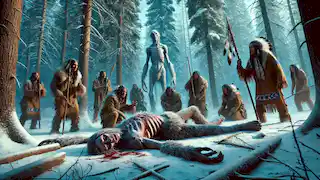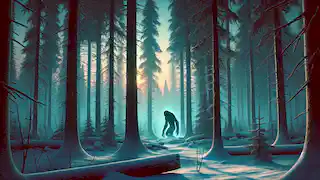<_img-Intro}}}
In the remote and icy forests of North America, particularly in the vast wilderness of Canada, there exists a legend that has haunted the Indigenous tribes for centuries. The story of the Wendigo is one of terror and survival, a cautionary tale passed down through generations. The Wendigo is not just a creature of myth but a manifestation of the darkest corners of the human soul, a warning of the dangers of greed, isolation, and hunger.
The Origin of the Wendigo
The legend begins in the coldest winter, a time when food was scarce, and survival was uncertain. The Algonquian-speaking tribes, including the Cree, Ojibwe, and Innu, believed in the Wendigo as a malevolent spirit or monster that roamed the forests in search of human flesh. It was said that the Wendigo was once a man, a hunter or a warrior, who succumbed to the ultimate taboo—cannibalism.
Driven by starvation and madness, the man devoured the flesh of his fellow tribesmen, and in doing so, he transformed into a Wendigo. This transformation was irreversible, as the man became consumed by an insatiable hunger that could never be satisfied. The Wendigo, tall and emaciated, with skin stretched tightly over its bones, and eyes sunken deep into its skull, would forever roam the wilderness, searching for its next victim.

The Curse of the Wendigo
The Wendigo was not just a physical being but also a spiritual curse. Those who ventured too far into the wilderness or were isolated for too long risked becoming a Wendigo themselves. The curse could be triggered by intense hunger, greed, or even envy. The Wendigo spirit would possess a person, slowly driving them mad until they too craved human flesh.
The tribes believed that once a person became a Wendigo, there was no hope of redemption. The only way to protect the community was to kill the Wendigo before it could kill others. This often meant a tragic end for the cursed individual, as their loved ones were forced to take their life to protect themselves.
The Wendigo’s presence was a constant reminder of the fine line between civilization and savagery, between humanity and monstrosity. It embodied the fear of losing oneself to the wild, of becoming something less than human.
The Sightings and the Fear
Over the years, there have been countless reports of Wendigo sightings. Hunters, trappers, and travelers have all claimed to have seen the creature lurking in the shadows of the forest, its eyes glowing in the darkness. The Wendigo was said to be incredibly fast, able to move through the trees with an eerie silence that made it almost impossible to detect until it was too late.
These sightings only fueled the fear and superstition surrounding the Wendigo. People would refuse to venture into certain areas of the forest, believing them to be cursed. Families would huddle together in their cabins during the long winter nights, telling stories of the Wendigo to remind themselves of the dangers that lurked just beyond the firelight.
Even today, the legend of the Wendigo persists, with some claiming that the creature still roams the forests of Canada and the northern United States, waiting for its next victim.

The Wendigo in Modern Times
In modern times, the legend of the Wendigo has taken on new forms, appearing in literature, films, and popular culture. The creature has become a symbol of the dangers of unchecked greed and the consequences of losing one's humanity. It has been used as a metaphor for everything from environmental destruction to corporate exploitation.
Despite these modern interpretations, the core of the legend remains the same. The Wendigo is a reminder of the darkness that exists within us all, a warning of what can happen when we allow our basest instincts to take over. It is a story that continues to resonate because it speaks to a universal fear—the fear of losing control, of becoming something monstrous.
The Hunt for the Wendigo
In some versions of the legend, there are those who dedicate their lives to hunting the Wendigo. These individuals, often shamans or warriors, were believed to possess the knowledge and power needed to defeat the creature. They would venture deep into the wilderness, armed with sacred weapons and rituals, to confront the Wendigo and protect their people.
The hunt for the Wendigo was not just a physical battle but a spiritual one as well. The hunter had to be strong in mind and spirit, able to resist the Wendigo's temptations and avoid falling into madness. The Wendigo was said to be able to manipulate the mind, creating illusions and sowing discord among those who sought to destroy it.
The final confrontation between the hunter and the Wendigo was always a battle of wills, with the outcome determining the fate of not just the hunter but the entire community. If the Wendigo was defeated, the curse would be lifted, and the people would be safe—at least until the next winter.
The Legacy of the Wendigo
The legend of the Wendigo is more than just a story; it is a reflection of the harsh realities of life in the wilderness. The Wendigo embodies the fears and challenges faced by the Indigenous peoples of North America, from the threat of starvation to the dangers of isolation. It is a reminder of the importance of community, of sticking together in times of hardship, and of the dangers of allowing greed and desperation to drive us apart.
Today, the Wendigo continues to be a powerful symbol in Indigenous culture, representing the struggle between good and evil, civilization and savagery, humanity and monstrosity. The story of the Wendigo is a reminder that the line between these opposites is thin and that it is up to each of us to choose which side we will stand on.
Conclusion
The Wendigo is a creature of legend, but its story is rooted in the very real fears and challenges faced by the Indigenous peoples of North America. It is a tale of survival, of the dangers of the wilderness, and of the darkness that exists within us all. The Wendigo is a reminder that we must always be vigilant, that we must resist the temptations of greed and desperation, and that we must hold on to our humanity, even in the face of the most extreme challenges.
The legend of the Wendigo is one that will continue to be told for generations to come, a timeless story that speaks to the deepest fears and truths of the human experience.

Epilogue: The Wendigo's Whisper
As the snow falls gently on the forest floor, the wind carries with it a whisper, a haunting echo of the Wendigo's presence. The trees stand tall and silent, their branches heavy with the weight of the snow, as if bowing to the ancient spirit that roams among them. The Wendigo may be a creature of legend, but its shadow still lingers in the hearts of those who know its story.
In the stillness of the night, if you listen closely, you might hear the faint sound of footsteps, the crackle of branches, and the whisper of a name long forgotten. The Wendigo is out there, waiting, watching, and hungering for the souls of those who dare to venture too far into the darkness.
Be careful where you tread, for the Wendigo is never far away, and its hunger is eternal.



















